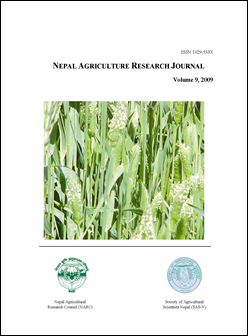Agro-morphological Variability Study of Barley (Hordeum vulgare L.) Landraces in Jumla, Nepal
DOI:
https://doi.org/10.3126/narj.v9i0.11635Keywords:
Hordeum vulgare, Landraces, Morphological variation, On-farm, On-stationAbstract
Barley is an important winter cereal crop in Jumla (2240-3000 masl), Nepal. It is grown in different cropping patterns in both Khet and Bari land conditions. A total of 207 accessions of barley landraces collected from various locations of Jumla were studied for agromorphological characteristics in Khumaltar and Jumla. Data on eight qualitative and five quantitative traits in 2-m row plot were recorded to assess diversity among the landraces. Bhuwali, Chawali, Lekali and Pawai were four farmer-named traditional barley varieties under cultivation in Jumla. A range of variability was observed among the accessions of barley landraces. All accessions are six-row covered barley possessing rough awns and whitish-brown grains. These landraces exhibit a range of variation in growth class, spike density and rachilla hair length. Lekali and Pawai are adapted to the high-altitude area of Jumla. Cluster analysis of measured data under on-farm and on-station conditions indicated five distinct clusters. Three principal components explained 84.3% and 60.2% of the total variation from on-station and on-farm, respectively.
Nepal Agric. Res. J. Vol. 9, 2009, pp. 1-11
Downloads
Downloads
Published
How to Cite
Issue
Section
License
This license allows reusers to copy and distribute the material in any medium or format in unadapted form only, for noncommercial purposes only, and only so long as attribution is given to the creator.




